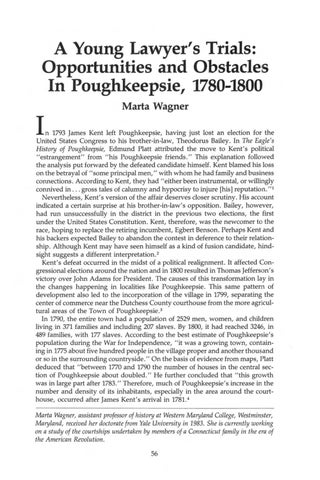A Young Lawyer's Trials: Opportunities and Obstacles In Poughkeepsie, 1780-1800 Marta Wagner
I
n 1793 James Kent left Poughkeepsie, having just lost an election for the United States Congress to his brother-in-law, Theodorus Bailey. In The Eagle's History of Poughkeepsie, Edmund Platt attributed the move to Kent's political "estrangement" from "his Poughkeepsie friends." This explanation followed the analysis put forward by the defeated candidate himself. Kent blamed his loss on the betrayal of "some principal men," with whom he had family and business connections. According to Kent, they had "either been instrumental, or willingly connived in. . . gross tales of calumny and hypocrisy to injure [his] reputation. " 1 Nevertheless, Kent's version of the affair deserves closer scrutiny. His account indicated a certain surprise at his brother-in-law's opposition. Bailey, however, had run unsuccessfully in the district in the previous two elections, the first under the United States Constitution. Kent, therefore, was the newcomer to the race, hoping to replace the retiring incumbent, Egbert Benson. Perhaps Kent and his backers expected Bailey to abandon the contest in deference to their relationship. Although Kent may have seen himself as a kind of fusion candidate, hindsight suggests a different interpretation.2 Kent's defeat occurred in the midst of a political realignment. It affected Congressional elections around the nation and in 1800 resulted in Thomas Jefferson's victory over John Adams for President. The causes of this transformation lay in the changes happening in localities like Poughkeepsie. This same pattern of development also led to the incorporation of the village in 1799, separating the center of commerce near the Dutchess County courthouse from the more agricultural areas of the Town of Poughkeepsie.3 In 1790, the entire town had a population of 2529 men, women, and children living in 371 families and including 207 slaves. By 1800, it had reached 3246, in 489 families, with 177 slaves. According to the best estimate of Poughkeepsie's population during the War for Independence, "it was a growing town, containing in 1775 about five hundred people in the village proper and another thousand or so in the surrounding countryside." On the basis of evidence from maps, Platt deduced that "between 1770 and 1790 the number of houses in the central section of Poughkeepsie about doubled." He further concluded that "this growth was in large part after 1783." Therefore, much of Poughkeepsie's increase in the number and density of its inhabitants, especially in the area around the courthouse, occurred after James Kent's arrival in 1781.4 Marta Wagner, assistant professor of history at Western Maryland College, Westminster, Maryland, received her doctorate from Yale University in 1983. She is currently working on a study of the courtships undertaken by members of a Connecticut family in the era of the American Revolution. 56









